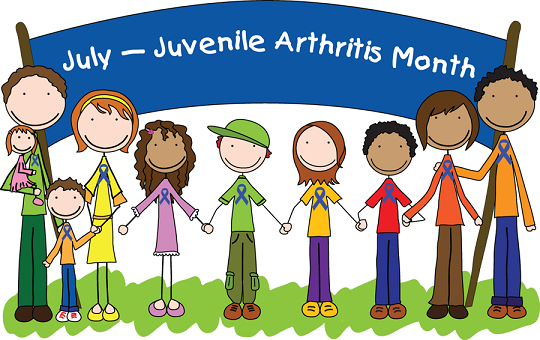July is Juvenile Arthritis month and as a child of someone that has suffered from Rheumatoid arthritis for over 30 years, I thought I would share some information about juvenile arthritis. Although my mom was diagnosed with arthritis as an adult, I still worry that maybe the disease will pass on to myself or even worse, one of my children. Children of parents with arthritis have a 10% chance of developing a similar condition. I was maybe six or seven at the time and I didn’t understand why she couldn’t go to the zoo or to amusement parks. The walking was just too much for her. She’s now in her mid 60s and although treatment for arthritis has improved, she still suffers from chronic pain. As the sixth most common chronic disease among children, arthritis affects more than 300,000 children in the U.S. This fact comes as a surprise to many, who associate the disorder with older adults.
“Juvenile rheumatoid arthritis, also known as juvenile idiopathic arthritis, is an autoimmune condition that affects the joints, causing pain and stiffness,” said Dr. Rafael Rivas-Chacon, Director of Rheumatology at Miami Children’s Hospital. Much like arthritis common among adults, juvenile arthritis can be physically painful, causing a child to have limited range of motion, sometimes affecting the ability to walk or stand. “Besides being physically challenging, many children with juvenile arthritis are faced with emotional challenges, as well,” said Dr. Rivas-Chacon. Because this is a disease so commonly associated with older adults, many children may feel isolated when their parents and other people in their lives lack understanding when it comes to their condition. That’s why it’s important for parents to know the symptoms, and that this is a disease that doesn’t just affect adults. In fact, kids can exhibit symptoms of arthritis as young as two-years old.
Knowing the Signs
A child with juvenile arthritis may complain of pain in his or her joints, bones or muscles. The child may also exhibit symptoms such as frequent fevers, rashes and swollen lymph nodes. Though seldom life threatening, some forms of juvenile arthritis can cause other complications if left untreated. This includes eye inflammation that can lead to cataracts or glaucoma. If treated with the proper medication and physical therapy, however, most children with juvenile arthritis can grow up living perfectly normal lives.
“Receiving treatment and/or therapy from early on can ensure the condition can be kept under control and can often ease most, if not all, of a child’s painful symptoms,” says Dr. Rivas-Chacon.
A Strong Support System
Emotional support from parents, friends and family can have a tremendous impact on a child living with juvenile arthritis. “It can be an isolating disease,” explains Dr. Rivas-Chacon that’s why for the rheumatology patients at Miami Children’s Hospital, there’s Camp Funrise, the first summer camp in Florida for patients with arthritis and other related conditions.”
Free and open to children ages 8 to 12, Camp Funrise is a summer program that aims to foster independence for kids who are unable to attend a traditional summer camp because of their special needs. The week-long, sleep away camp provides both support and recreational activities like swimming with the dolphins and other fun activities. “It’s important for both our patients and their parents to feel empowered, not defeated by the juvenile arthritis. At the same time, the camp provides an environment to build relationships with other families who can relate to and support each other.” For more information on treating juvenile arthritis, as well as information on Miami Children’s Hospital’s Camp Funrise, please visit mch.com.


Leave a Reply